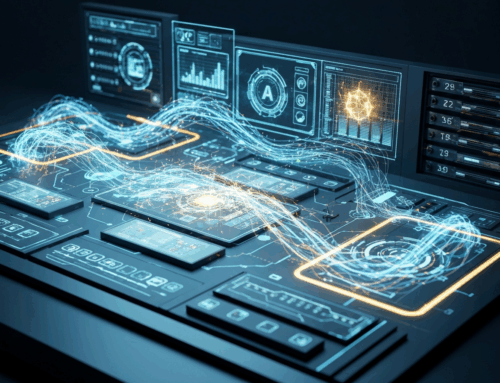The AI Economy Mandate Moving Beyond Robotic Process Automation (RPA)
The operational landscape for modern businesses is shifting dramatically, demanding a move from rigid, rules-based systems to adaptive, intelligent workflows. Traditional Robotic Process Automation (RPA) delivered significant initial value by automating high-volume, repetitive tasks based on strictly predefined rules. However, the modern enterprise requires more than mere task replication; it requires a system capable of handling ambiguity, unstructured data, and dynamic decision-making.
This necessity has driven the rapid evolution and adoption of next-generation **AI Workflow Automation Tools**. These platforms leverage the power of Large Language Models (LLMs) and Agentic AI to create processes that can reason, learn, and act autonomously. While RPA bots excel at following fixed scripts—such as clicking specific fields in a legacy system—they fail when the interface changes or when the data is messy. The new mandate is to deploy intelligence at every touchpoint, from customer service to financial reporting, creating an operational agility that simply was not possible with the previous generation of tools. As companies scale, they are realizing that operational efficiency is no longer about simply automating what exists, but fundamentally redesigning processes around AI-driven capabilities. McKinsey reports that generative AI could automate 60–70% of employees’ time-consuming tasks, underscoring the shift away from basic RPA towards a more comprehensive and cognitive approach to business process automation.
Defining Intelligent Automation The Synergy of LLMs, Machine Learning, and NLP
Intelligent Automation (IA) is the convergence of traditional workflow automation with cognitive technologies such as Large Language Models (LLMs), Machine Learning (ML), and Natural Language Processing (NLP). This synergy is what separates modern AI tools from their RPA predecessors. Intelligent systems possess the context and adaptability to handle the nuanced, human elements of business processes.
The core components of intelligent automation include:
- Large Language Models (LLMs): These models provide the core reasoning and generative capabilities. Embedded LLMs allow a workflow to interpret complex instructions, generate tailored responses, and make multi-step decisions based on vast amounts of data—actions far beyond the scope of a simple RPA script.
- Natural Language Processing (NLP): NLP enables the system to understand and process human language, which is crucial for handling unstructured data. Whether it is reading sentiment from an incoming support ticket, extracting key entities from a contract, or summarizing a long email chain, NLP transforms chaotic information into structured data points for the automation to act upon.
- Machine Learning (ML) Algorithms: ML is the engine that drives continuous improvement. These algorithms allow the system to learn from historical outcomes, enabling predictive analytics, anomaly detection, and self-optimization. For example, an ML model can forecast a project delay and automatically trigger a mitigation workflow.
This technological foundation gives rise to Agentic AI—autonomous software entities capable of reasoning through goals, dynamically planning steps, executing tasks across multiple systems, and course-correcting based on real-time feedback. This represents a paradigm shift from simple execution to genuine operational intelligence.
Building the Agentic Backbone API Integrations, Python, and Low-Code Orchestration
Moving from the theoretical concept of an AI agent to a functioning enterprise system requires establishing a robust technical backbone. The modern AI workflow is rarely a monolithic application; it is an orchestration of interconnected services, APIs, and business logic. Successful implementation hinges on blending enterprise-grade integration capabilities with flexible, developer-friendly tools.
For many businesses, the journey starts with commercial low-code tools like Zapier or Make, which provide extensive app connectivity and user-friendly interfaces for simple flows. However, when processes involve high data volume, custom business logic, or unique internal systems, custom development becomes essential. This is the domain of powerful, developer-centric platforms and custom code, which Idea Forge Studios specializes in delivering.
The Role of Custom Development and Open-Source Tools
Platforms like n8n offer an open-source, node-based alternative that caters directly to the technical user who needs more control. While low-code platforms are excellent for citizen developers, tools built around custom scripting and API integration provide the necessary depth for complex, enterprise-grade automations.
- API Integrations: A custom AI solution is built around service-oriented architecture (SOA). Whether integrating a custom-trained LLM via FastAPI or pulling data from a legacy CRM, direct API integration is paramount.
- Python for Business Logic: Python remains the universal language for AI/ML and advanced workflow logic. Developers use it to clean data, run complex computations, and define sophisticated agent behaviors that low-code builders cannot manage.
- Orchestration: Tools like n8n and Airflow (a data workflow orchestrator) are key for managing the sequence, dependencies, and error handling of multi-step processes across systems. They ensure workflows are reliable, auditable, and maintainable.
For organizations looking to deploy customized, scalable digital operations—from bespoke e-commerce automation to internal process orchestration—the ability to build with a blend of professional-grade tools and custom code is the defining differentiator. This tailored approach allows for integrating AI agents directly into your core business operations, such as enhanced content management systems built by experienced WordPress developers or custom applications.
Choosing the Right Platform The Best AI Workflow Automation Tools for Enterprise Scale
Selecting the appropriate platform for your AI automation journey depends entirely on the required complexity, existing technical stack, and data governance needs. The market is segmented into several key categories, each serving distinct strategic goals.
A Spectrum of AI Workflow Solutions
The modern landscape of **AI Workflow Automation Tools** ranges from accessible, cloud-based integrators to highly customizable, enterprise orchestration systems. Businesses must assess whether they need simple app connectors or a complete system for intelligent process management.
| Platform Type | Best For | Core AI Capability |
|---|---|---|
| Hyper-Automation Suites (e.g., UiPath, Automation Anywhere) | Large enterprises migrating from RPA; document-heavy, compliance-focused processes. | Intelligent Document Processing (IDP), Computer Vision. |
| Integration Platforms (iPaaS) (e.g., Workato, Domo) | Cross-functional enterprise integration; connecting cloud and legacy systems. | AI-driven data mapping, predictive analytics, real-time alerts. |
| Visual No-Code Platforms (e.g., Zapier, Make, Relay.app) | Small teams; fast, simple app-to-app automations; non-technical users. | Natural language prompt automation; text summarization. |
| Developer/Open-Source Tools (e.g., n8n, Windmill) | Technical teams needing self-hosting, custom code, and complex logic (like Python or JavaScript). | LLM integration via custom API calls; data pipeline orchestration. |
Platforms like monday work management (with AI Blocks) and Microsoft Power Automate focus on enhancing existing work management and ecosystem tools with embedded AI features. For enterprises, the key differentiator is often not the LLM itself, but the surrounding architecture—how the platform handles governance, security, auditing, and real-time data flow, a factor that is particularly emphasized in high-throughput data processing environments.
Idea Forge Studios maintains the authoritative view that while low-code tools are valuable for quick wins, achieving scalable, secure, and future-proof automation often necessitates custom development and professional orchestration, especially when bridging legacy systems or building proprietary agents.
Strategic Value Proposition Automated Data Processing and Measuring AI ROI
The true value of modern AI automation is realized not merely through task substitution, but through its capability to generate strategic advantage. This is most evident in the fields of automated data processing, predictive decision-making, and measurable Return on Investment (ROI).
Automated Data Processing: The Foundation of Intelligence
Intelligent Automation platforms fundamentally solve the challenge of unstructured data. Documents, emails, chat transcripts, and web data—which account for the majority of enterprise information—are chaotic for traditional automation. AI changes this:
- Intelligent Extraction: Using computer vision and NLP, AI can extract data points from invoices, legal contracts, or customer feedback forms with high accuracy, automatically validating and routing the information.
- Contextual Classification: Beyond simple extraction, AI classifies the data by sentiment, intent, and priority, ensuring that a support ticket is correctly tagged and escalated not just by keywords, but by the urgency of the language used.
- Real-Time Activation: Platforms like Domo are built on the principle that insights must immediately translate to action. They operationalize data by integrating AI models directly into real-time data feeds, allowing workflows to adapt instantly when a predictive threshold is crossed.
This automated processing capability is critical for sectors like e-commerce, where rapid inventory updates, dynamic pricing changes, and personalized customer interactions drive revenue. Leveraging advanced intelligence enables businesses to deliver faster and more accurate fulfillment, enhancing the customer experience on platforms like those built with Idea Forge Studios’ e-commerce solutions.
Measuring AI ROI: Beyond Headcount Reduction
Measuring the ROI of AI automation must look beyond simple cost reduction. Key performance indicators (KPIs) should focus on strategic gains:
- Accuracy Gains: Reduced financial errors, compliance breaches, or data inconsistencies.
- Cycle Time Reduction: The time saved in core business cycles, such as lead-to-cash or order-to-fulfillment.
- Risk Mitigation: The value of preventing unforeseen issues, measured by reduced downtime or fewer escalations.
By automating the data-to-decision pipeline, companies move from reactive operations (fixing problems after they happen) to proactive operations (anticipating and preventing problems). This strategic move offers compounded value that far exceeds the simple labor cost savings of traditional RPA.
From Strategy to Execution How to Pilot Custom AI Solutions and Agentic Workflows
The transition to a fully intelligent, agentic workflow architecture is a strategic journey, not a feature rollout. Successful execution demands a focused pilot program, a clear governance model, and internal expertise, especially when building custom AI agents that interact with your core systems.
Designing the Pilot Program
The most effective strategy is to start small, target a high-value, repetitive process, and establish measurable metrics before scaling. Organizations with a formal AI strategy are statistically more likely to report success.
- Identify the Right Use Case: Focus on processes that involve high manual volume, require cross-system data correlation, and generate clear, measurable outcomes (e.g., processing vendor invoices, triaging support tickets based on sentiment).
- Define Agent Scope: Clearly delineate the boundaries of your AI agent. What systems can it access? What decisions can it make autonomously? For custom agent development, the scope must be precisely defined and built using secure, structured technologies.
- Establish a Feedback Loop: The continuous learning aspect of AI means that initial deployments require human-in-the-loop validation. The system must report on its decisions and outcomes so human experts can refine the ML models and logic, ensuring the agent becomes smarter over time.
Governance, Security, and Customization
As agents gain autonomy, governance and security become non-negotiable. Enterprise-grade AI requires secure integration with internal systems and compliance with data residency rules. This is where the core expertise of a specialized firm like Idea Forge Studios comes into play. We are not merely integrating off-the-shelf tools; we are developing the custom AI solutions and Agentic Workflows that provide end-to-end control.
Custom solutions, often built on robust backends with strong security protocols, allow a business to define its own logic, ensuring adherence to internal policies and regulatory requirements that off-the-shelf tools might overlook. Furthermore, managing the complexity of these intelligent systems often requires dedicated infrastructure planning. Whether it’s ensuring your e-commerce data flow is seamless, or that your AI agent deployment is stable, the foundation must be reliable. This is supported by professional infrastructure management and SEO maintenance, such as hosting and SEO for WordPress platforms, which provides the stability needed for continuous operation.
By prioritizing a strategic approach that blends best-in-class AI Workflow Automation Tools with expert custom development, businesses can successfully navigate the complexities of agentic AI, transforming operations and establishing a sustainable competitive edge.
Ready to Deploy Custom Intelligent Automation?
Move beyond basic RPA. If your business requires scalable, secure, and custom Agentic Workflows for web development, e-commerce, or complex operations, Idea Forge Studios can help.
Schedule Your Strategic AI Consultation
Or reach out directly:
Call us at (980) 322-4500 |
Email us at info@ideaforgestudios.com








Get Social